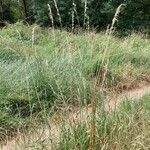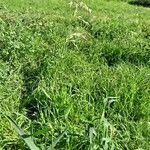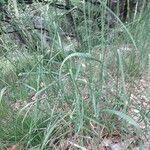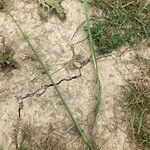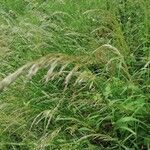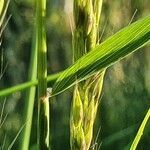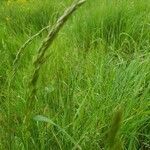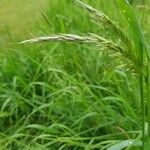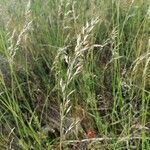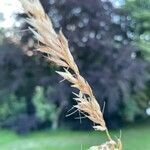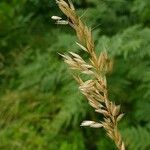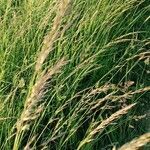Culms 50–180 cm high; mid-culm nodes exposed. Leaves scattered along culms; ligule 0.9–2 (–3) mm long; blade 13–23 (–40) cm long, 2–6 (–11) mm wide, adaxially glabrous or sparsely pilose or scabrous and pilose, abaxially glabrous or scabrous. Panicles (7–) 9–30 cm long. Spikelets 7–11 mm long (excluding awns), with 1 (–3) female-fertile floret(s). Lower glume (3–) 4–7 mm long, 1-nerved; upper glume 7–10.6 mm long, 3 (–5)-nerved. Male lemma ±equal to or slightly longer than female-fertile lemma, scaberulous especially towards apex, when villous hairs present in lower c. 1/2 then usually less hairy than on upper lemma; awn much longer than lemma body, usually 10–20 mm long, arising from 1/4–2/3 lemma length from base but usually in basal 1/3. Female-fertile lemma narrowly ovate to narrowly elliptic, entire, (6.5–) 7–10 mm long, dorsally rounded but often upwardly ±keeled, 7-nerved, scaberulous, usually antrorsely villous towards base, awnless or with a subapical (or arising from upper 1/3 of lemma), short, straight bristle or awn to 6 mm long, or occasionally with a geniculate awn (similar to basal lemma awn) to 12 mm long arising from about or above midway; palea slightly shorter than lemma, narrow, with keel nerves ciliolate. Anthers (3–) 4–5.1 mm long.
Culms erect or geniculate at base, rather stout, 1–1.5 m tall, 4–5-noded. Leaf sheaths loose, glabrous; leaf blades 14–30 cm, 3–9 mm wide, scabrid or abaxial surface smooth, apex acuminate; ligule 1–3 mm, obtuse or truncate. Panicle lanceolate to oblong in outline, loose to rather dense, 10–25 cm, greenish or purplish, shining; branches clustered,scabrid. Spikelets oblong, 7–9 mm, florets separated by short rachilla internode not more than 0.6 mm; glumes lanceolate, apex acute; lower glume 4–6 mm, upper glume equal to spikelet, punctiform scabrid; lemmas oblong-lanceolate, 7–9 mm, sparsely pubescent in lower 1/3 or glabrous, scabrid in upper 1/3; awn of lower lemma 1–2 cm, arising from lower 1/3 of lemma back; awn of upper lemma 1–2 mm, arising above middle or near apex. Anthers 4–5 mm. 2n = 28.
Tufted, short-lived perennial to 2 m; culms smooth, or minutely hairy at the nodes; sheaths smooth; blades scabrous, 4–8 mm wide; infl shining, slender, 1–3 dm, the short branches fascicled; glumes lance-ovate, acute or acuminate, the first 4.5–8 mm, the second 6.5–10 mm; lemmas glabrous or sparsely pilose; awn of the lower lemma 10–20 mm, geniculate near the middle; awn of the upper lemma 0–6 mm; anthers 4 mm; 2n=14, 28, 42. Meadows, roadsides, and waste ground, usually in moist soil; native of Europe, now widespread in the U.S. and found throughout our range. Plants with the lower internodes short, thickened into a series of subglobose corms 1 cm thick, are sporadic with us and have been distinguished as var. bulbosum (Willd.) Spenner.
Loosely tufted perennial 500-1400 mm high; basal internodes sometimes swollen; culms solitary, nodes glabrous or hairy. Leaf blade 100-190 x 2-5 mm. Inflorescence usually an open to sometimes a contracted panicle, branches filiform, conspicuously unequal. Spikelet 7-11 mm long; lower lemma awned from back towards the base, awn conspicuous, well developed, stout, geniculate; upper lemma awnless, or shortly awned or awned from middle; anthers 2.5-4.5 mm long.
A grass. It forms loose tufts. The flowering stem is 1.25 m tall.
